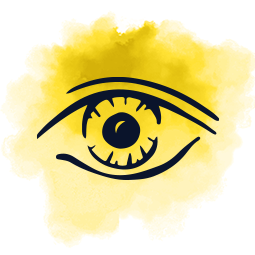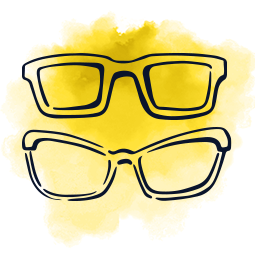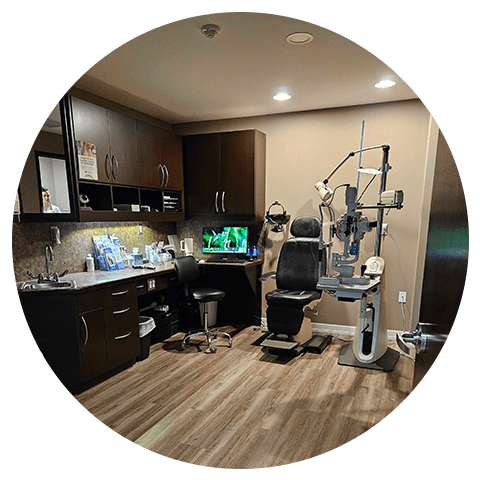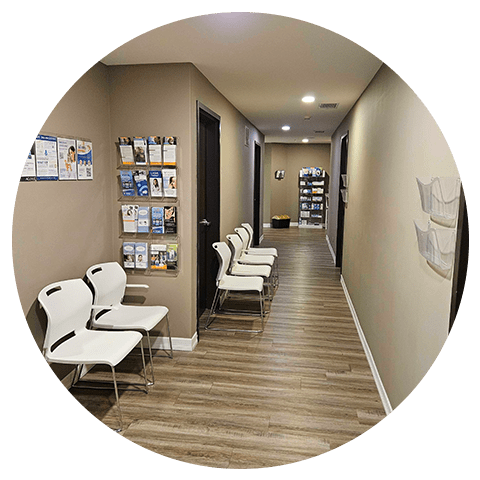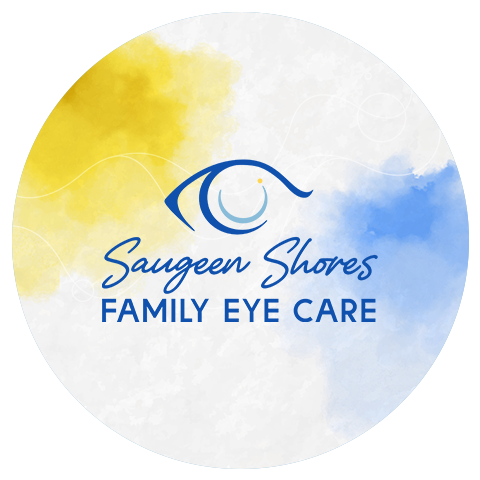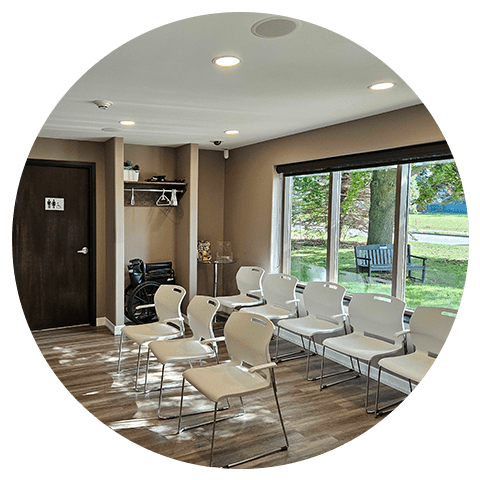Detecting & Diagnosing Eye Diseases
An eye exam is an important part of preventive healthcare. Not only will your optometrist update your lens prescription, but during an eye exam, they’ll also check for the development of eye diseases.
Many eye diseases can damage your vision permanently and progress without any noticeable symptoms, particularly in the beginning.
Early identification is crucial to the treatment and management of eye diseases. If your optometrist catches them early enough, they may be able to slow down progression or prevent vision loss.
Your sight is precious. Safeguard it today with a comprehensive eye exam.
Book AppointmentGlaucoma
Glaucoma is a group of eye diseases generally characterized by damage to the optic nerve, usually by high intraocular pressure.
Pressure builds up inside the eye, damaging the optic nerve and causing irreversible vision loss. Often, the progression of glaucoma is slow and not easily noticeable, as it often impacts your peripheral vision first, earning the disease the nickname “the silent thief of sight.”
There are several types of glaucoma.
Open-Angle Glaucoma
Fluid buildup caused by blockage of the eye’s drainage channels can increase intraocular pressure (IOP) and cause open-angle glaucoma. Generally, peripheral vision is the first thing impacted, followed by central vision.
Angle-Closure Glaucoma
Angle-closure glaucoma occurs when the space between the iris and cornea narrows, trapping fluid in the eye. When the pressure rises as a result of this fluid, angle-closure glaucoma occurs.
It can appear suddenly (acute) or progress gradually (chronic). Acute angle-closure glaucoma is a medical emergency. Sudden onset headaches, blurry vision, eye redness, or halos appearing around lights mean you should call your optometrist immediately.
Other Types of Glaucoma
Secondary glaucoma occurs when intraocular pressure is caused by eye trauma, injury, or infection.
When the optic nerve is damaged, but intraocular pressure remains within normal range, normal-tension glaucoma may be the cause.
Glaucoma Risk Factors
Glaucoma risk factors may include:
- A family history of glaucoma
- Extreme refractive errors
- Past eye injury or trauma
- Use of certain medications
- Heart disease, diabetes, or high blood pressure
Cataracts
As you age, the clear lens of your eye can thicken and become opaque. This is called a cataract. They are often the result of the normal aging process, though they can be present at birth.
Symptoms of Cataracts
Cataracts generally develop without pain or redness. Some symptoms of cataracts might include:
- Foggy or blurry vision
- Difficulty seeing at night
- Seeing halos around lights
- Muted colour vision
- Sensitivity to light
Preventing Cataracts
Cataract growth can be slowed by protecting the eyes from UV rays—a great pair of sunglasses can help! Eating foods rich in antioxidants like blueberries, apples, artichokes, and dark green veggies like kale and broccoli may also help to prevent cataracts.
Cataract Treatment
Often, obstructions to vision as a result of cataracts can be remedied through corrective lenses. But, cataracts can increase in size and may get to a point where glasses or contact lenses no longer provide the vision you want. In this case, we may recommend surgery.
If you’re having difficulty driving or performing your job safely, are struggling to watch television or read, or are experiencing challenges with daily activities that are decreasing your quality of life, it might be time to explore surgery.
Cataract surgery is safe and effective, and we will help you understand the procedure and your options.
Age-Related Macular Degeneration
Age-related macular degeneration (AMD) causes the breakdown of the macula, the area of the eye responsible for central vision. Damage to the macula can lead to central vision loss.
The central vision is responsible for reading, writing, driving, and recognizing faces, so any loss of vision in this area may make day-to-day tasks difficult.
People with AMD may not experience any pain or symptoms as the disease progresses. If straight lines begin to appear wavy or your central vision blurs in a way that glasses cannot correct, it’s time for an eye exam.
There are 2 types of AMD. Click each title to learn more.
Dry AMD
Dry AMD is the most common type of AMD, accounting for 90% of cases. It occurs when parts of the macula become thinner due to aging and accumulate tiny clumps of protein.
While there is no cure for dry AMD, there are ways to slow its progression, such as taking specific supplements and using innovative treatments like MacuMira. These options can help manage the condition and preserve vision over time.
Wet AMD
The less common type of the disease, wet AMD, is responsible for the majority of cases of blindness as a result of AMD. Wet AMD occurs when blood vessels grow under the retina and leak fluid into the macula.
At Saugeen Shores Family Eye Care, we use OCT scans at every exam to detect early signs of wet AMD. Early detection leads to better treatment outcomes. If we identify wet AMD, we’ll promptly refer you to an ophthalmologist for specialized care.
We’re on the Lookout for Early Signs of Eye Disease
Regular, comprehensive eye exams are the best defence against eye diseases that can cause irreversible vision loss.
Book your appointment today, and let us examine your eyes for early signs of eye disease.
Book AppointmentVisit Our Location
Visit Us
We’re located on Devonshire Road just off the highway, tucked in behind the tennis courts at Lakeshore Recreation and across the road from Unleash the Pawsitive.
Please visit Google for any other hours of operation changes.
Our Address
- 643 Devonshire Road
- Port Elgin, ON N0H 2C3
Contact Information
- Phone: 519-832-5511
- Fax: 519-832-3278
- Text: 519-832-5511
- Email: hello@ssfeyecare.com
Our Hours
- Monday: 8:30 AM – 6:30 PM
- Tuesday: 9:30 AM – 6:30 PM
- Wednesday: 8:30 AM – 6:30 PM
- Thursday: 8:30 AM – 6:30 PM
- Friday: 8:30 AM – 4:30 PM
- Saturday: Closed
- Sunday: Closed
-
We’re closed on all stat holidays & weekends.
Our Brands








Our Google Reviews

Land Acknowledgement
We acknowledge the Town of Saugeen Shores is located on the traditional lands and treaty territory of the Saugeen Ojibway Nation, which consists of the Chippewas of Saugeen and the Chippewas of Nawash Unceded First Nation. We understand this land holds immense significance to the people of Saugeen Ojibway Nation. We appreciate those who live and work alongside us today and who continue the traditions of their ancestors as stewards of the land we are privileged to inhabit. We thank them for their contributions in caring for the land and shaping this community.


